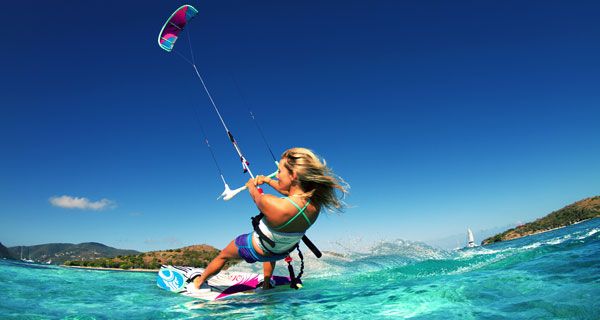Kitesurfing or kitesurfing (sometimes called kiteboarding or flysurfing) is a mix of surfing, wakeboarding, wakeskate and paragliding. It is a sliding sport, with the use of a traction sail (kite) similar to a kite or parachute, which pulls the athlete (kitesurfer or rider) by four or five lines (also called ropes or ropes) , two fixed to a carbon bar (steering) that go to both ends of the sail, and the remaining two or three (power) that pass through the center of the bar and are attached to the body by a harness, allowing to slide over water through a table designed for that purpose. It even allows you to literally keep flying for several seconds, hence in Europe they call it flysurfing. The kite, in turn, has tubes, or ribs that inflate like a lifesaver so that when it falls into the water it can float and take flight again.
Only informatively we want to mention the main differences with windsurfing and it is that the latter moves through the use of a sail, while in kitesurfing the displacement is for a kite or parachute. It also does not require so much strength or technique so you learn faster and barely with a course, the person may soon be navigating. The similarity between the two is that the person who practices it rests on a board or ski suitable for practice.
An important point to know is that all kite equipment has a safety system so that the navigator can get loose from the lines in case the sail lifts it from the ground and raises it; Many have been injured because they did not know how to hail it. Therefore we must say that it is a high risk sport so it must be practiced with the necessary preventions and knowledge. However, the design of the kites is advancing by leaps and bounds, they are increasingly safe and stable and that is why more and more people venture to take their first steps in this sport.
Although the practice of this sport in an extended manner is very recent, it was in 1977 when Gijsbertus Adrianus Panhuise patents a navigation system on a surfboard pulled by a kind of parachute, thus becoming the father of this sport.
Nowadays it is one of the sports that has had greater growth in the last decade. Those who know say that, although it may not seem like it, learning it is not simple but, after the first attempts, it becomes addictive. In Indonesia it is a culture and an art, the designs are wide and varied, in these areas is where the kiteboarding industry is located.
As for the modalities, they can be practiced; jumps and maneuvers (freestyle), regattas between buoys (race) and surf in waves (surfkite). Some also practice it on snow using a ski board or wakeboard.
The basic equipment of kitesurf consists of:
-Cometa: There are several types of kites depending on the mode of navigation you want to make and attending to this there are a number of types of specialized kites for each case.
-Brake of address
-Arnes
-Table: The table is an element that we must take into account if we want to progress quickly at the beginning of the sport. The most used tables are the TwinTip, exclusive tables and created solely for this sport. They are bidirectional, which means that your navigation will be the same in both directions, just by changing the course. Other tables widely used in different disciplines of kitesurfing is the directional board or surfboard that as its name indicates only moves in one direction.
-4 or 5 lines (ropes to the kite)
-Leash, safety line of the harness to the bar
And optionally it can include security and comfort elements such as:
-Helmet
– Life jacket (flotation or impact)
-Neoprene suit and booties
-buggy sand
-monopatin off-road
In particular, the province of Mendoza offers ideal natural attributes for the development of Kitesurfing, both for its wind, climate and water conditions, as well as for its tourist interest as a destination for adventure sports. October to December, is the best season for your practice both at the Potrerillos Dam, at the foot of the foothills with a privileged view, as well as at Los Reyunos Dam, also surrounded by imposing valleys.






